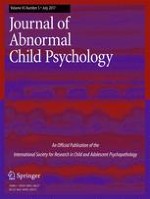22-09-2016
Executive Functioning and Engagement in Physical and Relational Aggression among Children with ADHD
Gepubliceerd in: Research on Child and Adolescent Psychopathology | Uitgave 5/2017
Log in om toegang te krijgenAbstract
Although evidence suggests that executive functioning (EF) impairments are implicated in physically aggressive behavior (e.g., hitting) these cognitive impairments have rarely been examined with regard to relational aggression (e.g., gossip, systematic exclusion). Studies also have not examined if EF impairments underlie the expression of aggression in children with attention-deficit/hyperactivity disorder (ADHD) and if child gender moderates risk. Children with and without clinical elevations in ADHD symptoms (N = 124; ages 8–12 years; 48 % male) completed a battery of EF tests. Parent and teacher report of ADHD and oppositional defiant disorder (ODD) symptoms and teacher report of engagement in physical and relational aggression were collected. Models tested the unique association of EF abilities with physical and relational aggression and the indirect effect through the expression of ADHD or ODD behaviors; child gender was also tested as a moderator. EF impairment was uniquely associated with physical aggression, but better EF ability was associated with relational aggression. For boys, poor EF also was indirectly associated with greater physical aggression through the expression of ADHD behaviors. However, ADHD symptoms were unrelated to relational aggression. ODD symptoms also predicted physical aggression for boys but relational aggression for girls. Results suggest that there are multiple and distinct factors associated with engagement in physical and relational aggression and that better EF may actually promote relational aggression. Established models of physical aggression should not be assumed to map on to explanations of relational aggression.
